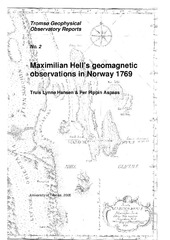Blar i utgivelsesdato Artikler, rapporter og annet (TGO)
Viser treff 1-20 av 42
-
Nordlysets årsak
(Journal article; Tidsskriftartikkel, 1980)Nordlys dannes av gass og strømmer ut fra sola. Denne solvinden stoppes av jordas magnetfelt, og energien i vinden fra sola overføres til negative og positive ladede partikler (elektroner og protoner) som skytes ned fra jordatmosfæren og gir nordlys. Vi skal i det følgende fortelle litt om sola, og hvorfor det er en gasstrøm fra sola. Vi skal også diskutere hva som skjer når solvinden treffer sola -
Nordlys i atmosfæren
(Journal article; Tidsskriftartikkel, 1980)Nordlyset er lys i atmosfæren som skyldes nedbør av energirike partikler - særlig elektroner, og de former og bevegelser vi ser i nordlyset skyldes variasjoner i denne atmosfæren. Når energirike elektroner nærmer seg jorden ovenfra, trenger de gjennom atmosfæren som stadig øker i tetthet. i 150-100 km's høyde blir atmosfærens tetthet så stor at elektronene begynner å kollidere med atmosfærenes atomer ... -
Det historiske nordlys
(Journal article; Tidsskriftartikkel, 1980)Nordlyset har vært omgitt av både mystikk og beundring. Det har inspirert kunstnere til betagende kunstverk og skremt andre til fortvilelse. Det er umulig å fastslå når den første beskrivelsen av nordlys har funnet sted. I det følgende kapitlet skal vi gå historiens vei og presentere noen inntrykk av de tidligste forestillingene om fenomenet, slike som en kan finne spør av i den muntlige tradisjon, ... -
Nordlysobservatoriet gjennom 50 år
(Journal article; Tidsskriftartikkel, 1980)De mange forsøk på å beskrive og forklare nordlyset som en finner i eldre litteratur vitner om lange tradisjoner for denne forskningen i vårt land. Norge ble av mange oppfattet som "Nordlysets Fædreneland" som biskop Spidberg fra Kristiansand uttrykte det allere i 1750. -
Radiobølgeforplantning i ionosfæren
(Journal article; Tidsskriftartikkel, 1980)Atmosfæren er bygd opp av nitrogen og oksygen. Opp til 60-70 km er atmosfæren stort sett nøytral, alle atomer har like mye positiv som negativ ladning. Høyere oppe vil røntgenstråling og energirike partikler forårsake ionisering, dvs. en del atomer blir spaltet i positive ion og frie elektroner. Det er dette høydeområdet fra ca. 60-1000 km, med relativt stor tetthet av drie ladede partikler, som nå ... -
Internasjonale forpliktelser
(Journal article; Tidsskriftartikkel, 1980)I forbindelse med at Nordlysobservatoriet har eksistert i 50 år kan det være på sin plass å spørre om det fortsatt er behov for virksomheten. Svaret er at observatoriet fyller en viktig oppgave i internasjonal forskning. -
On the possibility of ion-drag to induce dynamic instability in the lower thermosphere neutral gas
(Journal article; Tidsskriftartikkel; Peer reviewed, 2000)Strong wind shears may result in dynamic instability, often characterised by the Richardson number lying between zero and 0.25. The extent to which electric-field driven ion flow may induce such neutral wind shears is examined. Further, it is proposed that, in the ionosphere, it is possible for electric fields to drive ion winds such that the collisionally induced neutral air response may be comparable ... -
Nordlysobservatoriet : historie og erindringer
(Book; Bok, 2000-03)Reidulv Larsen og Steinar Berger tilbragte begge det meste av sitt yrkesaktive liv på Nordlysobservatoriet, fra 1940-tallet og fram mot 1990. Gjennom et så langt tidsrom oppsamles et betydelig forråd av kunnskap om institusjonens liv og historie og minner fra arbeidet der. Dette heftet har form av en historisk oversikt, men gjør ikke krav på å være en komplett eller objektiv sådann. -
An analogy to the Reynolds number for the neutral gas component of a weak plasma
(Journal article; Tidsskriftartikkel; Peer reviewed, 2001)The Reynolds number Re is used as a metric to assess whether or not a flow may contain turbulence. In a weakly ionised gas with an external electric field imposed, ions exert a drag on the neutral particles. Thus, a component of the neutral motion is attributable to the ion-drag. An analogy to Re has been proposed in which the ion-drag-induced velocity contribution to the neutral motion is used. ... -
The 16-day planetary waves: multi-MF radar observations from the arctic to equator and comparisons with the HRDI measurements and the GSWM modelling results
(Journal article; Peer reviewed; Tidsskriftartikkel, 2002)The mesospheric and lower thermospheric (MLT) winds (60–100 km) obtained by multiple MF radars, located from the arctic to equator at Tromsø (70° N, 19° E), Saskatoon (52° N, 107° W), London (43° N, 81° W), Hawaii (21° N, 157° W) and Christmas Island (2° N, 157° W), respectively, are used to study the planetary-scale 16-day waves. Based on the simultaneous observations (1993/1994), the variabilities ... -
Periodicities in energy dissipation rates in the auroral mesosphere/lower thermosphere
(Journal article; Peer reviewed; Tidsskriftartikkel, 2003)It is possible for medium-frequency (MF) radar systems to estimate kinetic energy dissipation rates by measuring signal fading times. Here, we present approximately 5 years of such results from Tromsø (69° N, 19° E) and in particular, investigate the periodicities present at different altitudes in the regime 80 to 100 km. We detect the known annual variation in the mesosphere and the semiannual ... -
Altitude calibration of the Tromsø medium frequency radar
(Research report; Forskningsrapport, 2004)Although the Tromsø Medium Frequency Radar situated at Ramfjordmoen, Norway (69°N, 19°E) has been operating for over a quarter of a century, no definitive altitude calibration has ever been documented using independent measurements of the same atmosphere. Here we perform calibrations using the recently installed (November 2003) Nippon/Norway Tromsø Meteor Radar by identifying wind features in ... -
Maximilian Hell's geomagnetic observations in Norway 1769
(Research report; Forskningsrapport, 2005)In the years 1768-1770 an expedition lead by the Austrian/Hungarian astronomer and Jesuit Father Maximilian Hell travelled to Vardø in the northernmost part of Norway. The main objective of the expedition was to observe the transit of Venus in June 1769. However, scientific investigations in several other fields were also performed, among them observations of the magnetic declination. From the ... -
Testing the hypothesis of the influence of neutral turbulence on the deduction of ambipolar diffusivities from meteor trail expansion
(Journal article; Peer reviewed; Tidsskriftartikkel, 2005-03-30)Fading times of radar echoes from underdense meteor trails in the upper mesosphere/lower thermosphere are commonly used to determine ambipolar diffusivities and hence ambient temperature. Diffusivities are generally expected to increase exponentially with height through the region from which the meteor trail echoes are obtained, viz., typically 70-110km altitude for a ~30-MHz radar. In practice, ... -
The red-sky enigma over Svalbard in December 2002
(Journal article; Tidsskriftartikkel; Peer reviewed, 2005-07-27)On 6 December 2002, during winter darkness, an extraordinary event occurred in the sky, as viewed from Longyearbyen (78° N, 15° E), Svalbard, Norway. At 07:30 UT the southeast sky was surprisingly lit up in a deep red colour. The light increased in intensity and spread out across the sky, and at 10:00 UT the illumination was observed to reach the zenith. The event died out at about 12:30 UT. Spectral ... -
Tidal signatures in mesospheric turbulence
(Journal article; Peer reviewed; Tidsskriftartikkel, 2006)We search for the presence of tidal signatures in high latitude mesospheric turbulence as parameterized by turbulent energy dissipation rate estimated using a medium frequency radar, quantifying our findings with the aid of correlation analyses. A diurnal periodicity is not particularly evident during the winter and spring months but is a striking feature of the summer mesopause. While semidiurnal ... -
Isolated lower mesospheric echoes seen by medium frequency radar at 70º N, 19º E
(Journal article; Peer reviewed; Tidsskriftartikkel, 2006-11-23)We have noted sporadic instances of strong isolated reflections of medium frequency (MF) radar waves from the mesosphere from as low as 50 km altitude and have devised a set of criteria for isolating these apparently anomalous echoes from those normally occurring from progressive partial reflections in the D-region. The object of this study is to map the occurrences of such echoes facilitating ... -
Polar vortex evolution during Northern Hemispheric winter 2004/05
(Journal article; Tidsskriftartikkel; Peer reviewed, 2007) -
Mesospheric turbulence during PMWE-conducive conditions
(Journal article; Tidsskriftartikkel; Peer reviewed, 2007) -
Climatic trends in E-region critical frequency and virtual height above Tromsø (70 degrees N, 10 degrees E)
(Journal article; Tidsskriftartikkel; Peer reviewed, 2007-11-29)We have examined the long time series of observations of E-region virtual height (1948–2006) and critical frequency (1935-2006) hitherto made by the Tromsø ionosonde at 70 degrees N, 19 degrees E. Combining a simplistic trend analysis with a rigorous treatment of errors we identify a negative trend in critical frequency. While a similar analysis of the virtual height h'E also suggests a negative ...


 English
English norsk
norsk


















